自主太空塢無人船
| 名稱 | |
|---|---|
| 地點 | |
| 簡稱 | ASDS |
| 所屬 | SpaceX |
| 發射台數 | 4個遠洋登陸平台(2個活躍; 1個正在生產; 1個已退役) |
| 「請閱讀說明書」號 (I)着陸歷史 | |
| 狀態 | 已退役 |
| 着陸 | 2 (0次成功, 2次失敗) |
| 首次着陸 | 2015年1月10日 (CRS-5) |
| 末次着陸 | 2015年4月14日 (CRS-6) |
| 相關火箭 | |
| 「當然我還愛你」號着陸歷史 | |
| 狀態 | 活躍 |
| 着陸 | 45 (39次成功, 6次失敗) |
| 首次着陸 | 2016年3月4日 (SES-9) |
| 末次着陸 | 2021年5月4日 (Starlink 25) |
| 相關火箭 | |
| 新「請閱讀說明書」號 (II)着陸歷史 | |
| 狀態 | 活躍 |
| 着陸 | 16 (16次成功, 1次失敗) |
| 首次着陸 | 2016年1月17日 (Jason-3) |
| 末次着陸 | 2021年4月29日 (Starlink 24) |
| 相關火箭 | |
| 「缺乏了個穩重」號着陸歷史 | |
| 狀態 | 活躍 |
| 首次着陸 | 2021年8月29日 (CRS-23) |
自主太空塢無人船(英文:Autonomous spaceport drone ship,簡稱:ASDS)是從甲板駁船衍生的遠洋船,配備了位置保持輪機和大型着陸平台,並由自主機械人控制。 航天公司SpaceX委託建造這種船隻,以便在海上回收火箭的第一級推進器,以執行運載火箭升至軌道或行星際軌道後載運的燃料不足以返回發射場的任務。
SpaceX有兩艘可操作的無人船。 「請閱讀說明書」號(Just Read the Instructions)與「當然我還愛你」號(Of Course I Still Love You),它們都在卡納維爾角的大西洋發射。 JRtI於2016年至2019年在太平洋為范登堡號發射場營運,然後於2019年8月離開洛杉磯港。截至2020年6月2日,有43架獵鷹9號試圖降落在無人船上,其中34架成功(78.6%)。還有一艘「缺乏了沉重度」號(A Shortfall of Gravitas,輕浮不正經之意,又譯重力不足,此處為雙關)仍在建造中。
ASDS是SpaceX目標中的關鍵早期營運組件,旨在通過「全面且快速的可重複使用性」[1]顯著降低太空發射服務的價格,並作為SpaceX承諾進行多年期可重複使用的火箭開發計劃的一部分進行開發技術。進入地球靜止軌道或超過逃逸速度的任何獵鷹飛行都需要在海上降落,這在SpaceX的發射任務中佔了大約一半。
歷史
[編輯]現役着陸船
[編輯]「當然我還愛你」號(Of Course I Still Love You)
[編輯]
自2015年初以來,第二艘ASDS着陸船「當然我還愛你」號(OCISLY)一直在路易斯安納州的一家造船廠建造,使用另一艘船體-Marmac 304-為東海岸的發射服務。它是第一架「請閱讀說明書」號的替代品,於2015年6月下旬進入獵鷹19航班19的營運服務。截至2015年6月,其母港為佛羅里達州傑克遜維爾,[2][3]但於2015年12月之後,它在卡納維爾港向南轉移了160英里(260公里)。
儘管該船的尺寸與第一批ASDS幾乎相同,但進行了一些改進,包括在後部貨櫃和登陸甲板之間豎立了一個鋼製防爆牆。該船已經準備好接受CRS-7任務的第一階段着陸測試,該測試於2015年6月28日發射失敗。[3]
2016年4月8日,發射「龍號CRS-8」飛船的第一階段成功降落在OCISLY上,這也是有史以來第一次無人控制降落。[4]
2018年2月,獵鷹重型試驗飛行的中央核心在OCISLY附近爆炸,炸毀了無人船上的四個推進器中的兩個。[5]從Marmac 303駁船上拆除了兩台推進器,以修理OCISLY。[6]
2020年5月30日,Demo-2任務的第一節推進器降落在OCISLY,Demo-2任務標誌着自2011年穿梭機最後一次飛行以來美國再次從美國本土在美國火箭上發射太空人升空,這也是SpaceX火箭首次發射太空人升空。[7][8]這標誌着有史以來第一次火箭的第一節將太空人送入太空,然後安全降落。
着陸任務
[編輯]第一次飛行測試是2015年1月10日,當時SpaceX進行了下降控制飛行測試,將獵鷹9號飛行14的第一階段降落到固體表面上,然後將其壓縮後的有效載荷放到地球軌道上。SpaceX預計,在首次着陸嘗試之前,成功着陸在平台上的可能性將為50%或更低。着陸從進行着陸測試變成了日常任務。
| 編號 | 日期 | 任務 | ASDS着陸任務描述 | 着陸結果 | 圖片 |
|---|---|---|---|---|---|
| 1 | 2015年1月10日 | SpaceX CRS-5 | SpaceX attempted a landing during SpaceX CRS-5 on Just Read the Instructions on 10 January 2015. Many of the test objectives were achieved, including precision control of the rocket's descent to land on the platform at a specific point in the North Atlantic Ocean and a large amount of test data was obtained from the first use of grid fin control surfaces used for more precise reentry positioning. However, the landing was a hard landing.[9] The SpaceX webcast indicated that the boostback burn and reentry burns for the descending first-stage occurred, and that the descending rocket then went "below the horizon," as expected, which eliminated the live telemetry signal. Shortly thereafter, SpaceX released information that the rocket did get to the drone spaceport ship as planned, but "landed hard ... Ship itself is fine. Some of the support equipment on the deck will need to be replaced."[9][10] | 失敗 | |
| 2 | 2015年2月11日 | DSCOVR | Just Read the Instructions was towed to sea for the Deep Space Climate Observatory satellite launch on 11 February 2015 but, it was not used for a landing attempt. Ocean conditions of 7米(23英尺)-high waves interfered with the ASDS recovery duties for the landing, so the ship returned to port and no landing test occurred. SpaceX executed a soft landing in the sea to continue data gathering for future landing attempts. The soft landing was successful, Elon Musk tweeted that it landed with a lateral accuracy of 10米(33英尺) away from the target and in a vertical position.[11] | No attempt | |
| 3 | 2015年4月14日 | SpaceX CRS-6 | On 14 April 2015, SpaceX made a second attempt during SpaceX CRS-6 to land a Falcon first-stage on the Marmac 300 drone ship Just Read the Instructions. News from Elon Musk suggested that it made a hard landing.[12] He later clarified that it appeared to have made a vertical landing on the ship, but then toppled over due to excessive remaining lateral momentum.[13] | 失敗 |  |
| 4 | 2015年6月28日 | SpaceX CRS-7 | In order to prepare for SpaceX CRS-7 on 28 June 2015, the then new ASDS, Of Course I Still Love You, was towed out to sea to prepare for a third landing test. This was its first operational assignment.[3] However, the Falcon launch rocket disintegrated before first-stage shutdown so the mission never progressed to the point where the controlled-descent test could happen.[14] | No attempt | |
| 5 | 2016年1月17日 | Jason-3 | In January 2016, SpaceX indicated that there would be an attempt to land on the then new ASDS, reusing the name Just Read the Instructions (JRtI), located on the west coast following the launch of Falcon 9 Flight 21 scheduled for 17 January 2016.[15] JRtI was located about 200英里(320公里) downrange from the launch site in the Pacific Ocean. Musk reported that the first stage did successfully soft-land on the ship, but a lockout latch on one of the landing legs failed to latch and the first stage fell over, causing a breach of the propellant tanks and a deflagration on impact with the drone ship.[16][17][18][19][20] | 失敗 |  |
| 6 | 2016年3月4日 | SES-9 | During a launch of a heavy communications satellite on Falcon 9 Flight 22 on 4 March 2016, SpaceX performed an experimental descent and landing attempt with very low propellant margins. For the first time, and in order to reduce the propellant required, SpaceX attempted the landing burn with three engines. SpaceX had indicated that the test was unlikely to result in a successful landing and recovery. In the event, one engine flamed out early, and the rocket hit Of Course I Still Love You (OCISLY)'s deck surface with considerable velocity, destroying the rocket and causing damage to the drone ship's deck.[21] By 21 March 2016, the deck of the drone ship was nearly repaired.[22] | 失敗 | |
| 7 | 2016年4月8日 | SpaceX CRS-8 | The Falcon 9 first-stage performed a successful landing on OCISLY in the Atlantic Ocean off the coast of Florida at T+9 minutes and 10 seconds after liftoff of SpaceX CRS-8,[23] the first-ever successful landing of a first stage on an Autonomous Spaceport Drone Ship.[24] The rocket was successfully affixed to the barge for the maritime transport portion of the journey back to port, and successfully completed its journey, entering Port Canaveral early in the morning on 12 April 2016.[24] | 成功 |  |
| 8 | 2016年5月6日 | JCSat-14 | SpaceX landed the first stage of the Falcon 9 on OCISLY during the JCSat-14 mission on 6 May 2016, its second time successfully landing on a drone ship at sea, and its first time recovering a booster from a high-velocity (GTO) mission.[25] | 成功 | 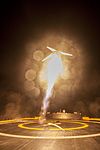 |
| 9 | 2016年5月27日 | Thaicom 8 | SpaceX landed the first stage of a Falcon 9 on OCISLY during the Thaicom 8 mission, its third time successfully landing on a drone ship at sea.[26] | 成功 | 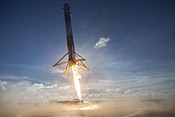 |
| 10 | 2016年6月15日 | ABS-3A/Eutelsat 115 West B | SpaceX failed to land the first stage of the Falcon 9 on OCISLY during the Asia Broadcast Satellite/Eutelsat mission.[27] Elon Musk tweeted that one of the three engines had low thrust, and when the rocket was just off the deck, the engines ran out of oxidizer.[28] | 失敗 | |
| 11 | 2016年8月14日 | JCSAT-16 | Falcon 9's 28th flight propelled the Japanese JCSAT-16 telecommunications satellite to a geosynchronous transfer orbit on 14 August 2016. The first stage re-entered the atmosphere and during the night landed vertically on OCISLY, positioned in the Atlantic Ocean nearly 400 miles from the Florida coastline; unlike previous successful landings, this landing-burn only used one engine, not three.[29] | 成功 | 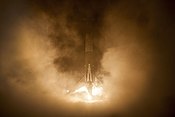 |
| 12 | 2017年1月14日 | Iridium NEXT-1 | The Falcon 9 first stage landed on the Pacific Ocean ASDS JRtI during the Iridium NEXT-1 mission.[30][31] This marked the first successful landing on JRtI and the first landing in the Pacific Ocean.[32][33] | 成功 | 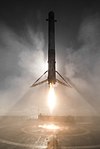 |
| 13 | 2017年3月30日 | SES-10 | The Falcon 9 first stage landed on OCISLY during the SES-10 launch. This was the first successful launch and landing of a previously flown orbital booster. | 成功 | 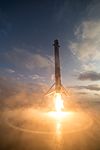 |
| 14 | 2017年6月23日 | BulgariaSat-1 | The Falcon 9 first stage landed on OCISLY during the BulgariaSat-1 launch. This was the second successful launch and landing of a previously flown orbital booster. This was also the first booster to have landed on both active drone ships. While the landing was considered a success, the booster was "slammed sideways" and suffered a 'hard landing' which resulted in 'most of the emergency crush core being used'. | 成功 | 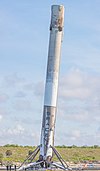 |
| 15 | 2017年6月25日 | Iridium NEXT-2 | 獵鷹9號的第一級推進器在Iridium-2任務期間降落於JRtI。 | 成功 | |
| 16 | 2017年8月24日 | 福爾摩沙衛星五號 | 獵鷹9號的第一級推進器在福爾摩沙衛星五號發射期間降落在JRtI上。 | 成功 |  |
| 17 | 2017年10月9日 | Iridium NEXT-3 | 獵鷹9號的第一級推進器在Iridium-3任務期間降落於JRtI。 | 成功 | |
| 18 | 2017年10月11日 | SES-11 | 獵鷹9號的第一級推進器在SES-11任務期間降落於OCISLY。 | 成功 | |
| 19 | 2017年10月30日 | Koreasat 5A | 獵鷹9號的第一級推進器在Koreasat 5A任務期間降落於OCISLY。 | 成功 | |
| 20 | 2018年2月6日 | Falcon Heavy Test Flight | On 6 February 2018, the central core from the Falcon Heavy Test Flight attempted a landing on OCISLY. There was not enough TEA-TEB igniter remaining and only the centermost of the three engines required ignited during the landing burn. The core hit the water near the drone ship at over 300 mph and was destroyed. The explosion of the central core upon impact also damaged two of the thrusters on the drone ship. The side boosters successfully landed at Landing Zones 1 and 2. The loss of the central core did not impact SpaceX operations since it was from an older generation of the Falcon 9 not intended to be reused.[5] | 失敗 | |
| 21 | 2018年3月6日 | Hispasat 30W-6 | On 6 March 2018, a Falcon 9 Full Thrust carrying the Hispasat 30W-6 communications satellite for Hispasat of Spain was originally supposed to attempt a landing, as the first stage was programmed to do the landing. However, due to sea conditions considered to be unfavorable, the drone ship was left at the port. The first stage did its pre-programmed maneuvers, but did not attempt to land.[34] | No attempt | |
| 22 | 2018年4月18日 | TESS | The Falcon 9 first stage landed on OCISLY during the TESS mission and was the 13th successful drone ship-based recovery.[35] | 成功 | |
| 23 | 2018年5月11日 | Bangabandhu-1 | The Falcon 9 Block 5 first stage landed on OCISLY during the Bangabandhu-1 mission and was the first flight of a Block 5 booster and upper stage. It was the overall 25th successful recovery of a booster. | 成功 | |
| 24 | 2018年7月22日 | Telstar 19V | 獵鷹9號的第一級推進器在Telstar 19V任務期間降落於OCISLY。 | 成功 | |
| 25 | 2018年7月25日 | Iridium 7 | 獵鷹9號的第一級推進器在Iridium 7任務期間降落於JRtI。 | 成功 | |
| 26 | 2018年8月7日 | Merah Putih | 獵鷹9號的第一級推進器在Merah Putih任務期間降落於OCISLY。 | 成功 | |
| 27 | 2018年11月15日 | Es'hail-2 | 獵鷹9號的第一級推進器在Es'hail-2任務期間降落於OCISLY。 | 成功 | 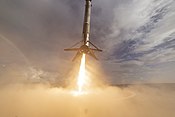 |
| 28 | 2018年12月3日 | SSO-A | 獵鷹9號Block 5第一級推進器在航天SSO-A任務期間降落在JRtI上,這是助推器首次成功降落3次。 | 成功 | 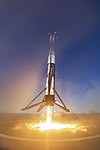 |
| 29 | 2019年1月11日 | Iridium 8 | 獵鷹9號Block 5的第一級推進器B1049在Iridium 8任務期間降落於JRtI。 | 成功 | |
| 30 | 2019年2月22日 | Nusantara Satu/Beresheet/ S5 | Falcon 9 block 5 first stage B1048 landed on OCISLY during the Nusantara Satu, Beresheet & S5 mission. | 成功 | 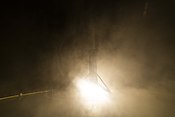 |
| 31 | 2019年3月2日 | SpX-DM1 | Falcon 9 block 5 first stage B1051.1[36] landed on OCISLY during the SpX-DM1 (SpaceX Demonstration Mission 1). | 成功 | 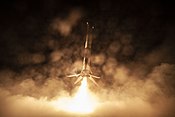 |
| 32 | 2019年4月11日 | Arabsat-6A | Falcon Heavy block 5 first stage's center booster B1055.1 landed on OCISLY. This was the first successful landing of a center booster used in a Falcon Heavy rocket. The side boosters also landed on their respective ground pads.[37] However, the recovery team was unable to secure the center booster onto the drone ship due to rough seas and the core was lost at sea.[38] | 成功 |  |
| 33 | 2019年5月4日 | SpaceX CRS-17 | Falcon 9 first stage B1056.1 landed on OCISLY during the SpaceX CRS-17 mission. The landing was originally scheduled for Landing Zone 1, but was switched after an explosion in a test of a Crew Dragon capsule at LZ1.[39] The launch of CRS-17 was delayed due to generator issues on the drone ship.[40] | 成功 | |
| 34 | 2019年5月24日 | 星鏈 L0 | 獵鷹9號第一級推進器B1049.3在星鏈L0任務期間降落在OCISLY。[41] | 成功 | |
| 35 | 2019年6月25日 | Space Test Program Flight 2 | 由於缺乏對中央發動機向量推力的控制,STP-2任務中的獵鷹重型中央推進器無法成功降落在OCISLY上,而兩側推進器則成功降落在地面着陸平台上。[42] | 失敗 | |
| 36 | 2019年11月11日 | 星鏈 L1 | 獵鷹9號的第一級推進器B1048.4在第二批Starlink任務中降落在OCISLY,這是獵鷹9號助推器首次進行第四次飛行並着陸。[43] | 成功 | |
| 37 | 2019年12月5日 | SpaceX CRS-19 | 在商業補給任務SpaceX CRS-19發射升空後,獵鷹9號的第一級推進器B1059.1成功降落在OCISLY。這是該助推器的首次飛行和降落。[44] | 成功 | |
| 38 | 2019年12月16日 | JSAT-18 | 在發射Kacific-1 / JCSAT-18通信衛星之後,獵鷹9號的第一級推進器B1056.3成功地降落在OCISLY,這是該助推器的第三次飛行和降落。[45] | 成功 | |
| 39 | 2020年1月7日 | 星鏈 L2 | 在Starlink L2發射升空之後,獵鷹9號的第一級推進器B1049.4成功地降落在OCISLY,這是Starlink的第三批衛星。[46] | 成功 | |
| 40 | 2020年1月29日 | 星鏈 L3 | 在星鏈 L3發射之後,獵鷹9號的第一級推進器B1051.3第三次成功着陸於OCISLY,這是從佛羅里達州卡納維拉爾角空軍基地SLC-40發射的第四批60顆Starlink衛星。[47] | 成功 | |
| 41 | 2020年2月17日 | 星鏈 L4 | 獵鷹9號第一級推進器B1056.4在第五批60顆衛星的星鏈 L4任務中發射升空後降落在水上。第一級助推器未能在無人船上降落,這是經飛行驗證過之助推器的首次降落失敗。[48] | 失敗 | |
| 42 | 2020年3月18日 | 星鏈 L5 | 獵鷹9號的第一級推進器B1048.5在發射過程中出現發動機異常後未能在OCISLY着陸。在2020年3月15日,由於發動機功率檢查期間數據不足而導致在T-0s時中止發射[49],該次發射任務被推遲到2020年3月18日。在T + 2:22時發生了發動機停機,這是自CRS-1以來獵鷹9號發生的第二次停機。據推測,助推器可能在大氣中破裂或墜入海洋。埃隆·馬斯克(Elon Musk)稍後在推特上證實,少量異丙醇被困在感測器的死角中,並在飛行過程中被點燃。[50] | 失敗 | |
| 43 | 2020年4月22日 | 星鏈 L6 | 獵鷹9號第一級推進器B1051.4成功降落在OCISLY。這是該助推器的第四次發射與着陸。[51] | 成功 | |
| 44 | 2020年5月30日 | 載人龍飛船示範2號 | 在Demo-2發射後,獵鷹9號的第一級推進器B1058.1成功着陸於OCISLY。這是SpaceX的第一個載人飛行任務,也是第一個將人類送入軌道並成功返回地球的獵鷹9號第一級推進器。[52] | 成功 | |
| 45 | 2020年6月3日 | 星鏈 L7 | 獵鷹9號第一級推進器B1049.5在發射星鏈L7任務後成功降落在JRTI上,這是第二枚成功重複飛行五次的獵鷹推進器。[53] | 成功 | |
| 46 | 2020年6月13日 | 星鏈 L8 | 獵鷹9號第一級推進器B1059.3成功降落在OCISLY上。[54] | 成功 | |
| 47 | 2020年6月30日 | GPS III SV03 | 獵鷹9號的第一級推進器B1060.1成功着陸在JRTI上。[55] | 成功 | |
| 48 | 2020年7月20日 | ANASIS-II | 已經在載人龍飛船示範2號任務中使用過的獵鷹9號第一級推進器B1058.2成功着陸在JRTI上。[56] | 成功 | |
| 49 | 2020年8月7日 | 星鏈 L9 | 獵鷹9號第一級推進器B1051.5成功降落在OCISLY。這是第三枚達到重複飛行五次的獵鷹助推器。[57] | 成功 |
參見
[編輯]參考資料
[編輯]- ^ Harwood, William. SpaceX readies rocket for station launch, barge landing. CBS News. 2014-12-16 [2014-12-23]. (原始內容存檔於2019-12-18).
A 300-foot-long barge will be used as an off-shore landing platform during launch of a SpaceX Falcon 9 rocket Friday. The primary goal of the flight is to deliver critical supplies and equipment to the space station, but SpaceX hopes to land the rocket's first-stage on the barge for possible refurbishment and reuse – a key milestone in the company's push to reduce launch costs.
- ^ @elonmusk. West Coast droneship under construction will be named "Of Course I Still Love You" (推文). 2015-01-23 –透過Twitter.
- ^ 3.0 3.1 3.2 SpaceX Augments and Upgrades Drone Ship Armada. NASASpaceFlight.com. 2015-06-18 [2015-06-18]. (原始內容存檔於2019-09-23).
- ^ SpaceX Rocket Makes Spectacular Landing on Drone Ship. Phenomena. [2016-04-10]. (原始內容存檔於2016-04-20).
- ^ 5.0 5.1 SpaceX. Space X News Conference. youtube.com. 2018-02-06 [2018-02-06]. (原始內容存檔於2018-12-05) (英語).
- ^ SpaceX's drone ship fleet spied prepping for future rocket recoveries. Teslarati.com. 2018-03-26 [2018-03-27]. (原始內容存檔於2019-12-18).
- ^ Potter, Sean. NASA Astronauts Launch from America in Test of SpaceX Crew Dragon. NASA. 2020-05-30 [2020-05-30]. (原始內容存檔於2021-03-23).
- ^ SpaceX Crew Dragon Demo-2 Key Launch Information. Launch360. [2020-05-30]. (原始內容存檔於2020-05-28) (美國英語).
- ^ 9.0 9.1 Clark, Stephen. Dragon successfully launched, rocket recovery demo crash lands. Spaceflight Now. 2015-01-10 [2015-01-10]. (原始內容存檔於2015-06-19).
- ^ * Musk, Elon. Rocket made it to drone spaceport ship.... Twitter.com. 2015-01-10 [2020-06-05]. (原始內容存檔於2016-03-05).
- Musk, Elon. Ship itself is fine.... Twitter.com. 2015-01-10 [2020-06-05]. (原始內容存檔於2016-03-05).
- Musk, Elon. Didn't get good landing/impact video.... Twitter.com. 2015-01-10 [2020-06-05]. (原始內容存檔於2016-03-05).
- ^ Musk, Elon. Rocket soft landed in the ocean.... Twitter.com. 2015-02-11 [2020-06-05]. (原始內容存檔於2016-03-04).
- ^ Musk, Elon. Ascent successful.... Twitter.com. 2015-04-14 [2020-06-05]. (原始內容存檔於2016-03-05).
- ^ Musk, Elon. Looks like Falcon landed fine.... Twitter.com. 2015-04-14 [2020-06-05]. (原始內容存檔於2016-03-05).
- ^ Harwood, William. SpaceX Falcon 9 rocket destroyed in launch mishap. CBS News. 2015-06-28 [2015-06-28]. (原始內容存檔於2020-09-13).
- ^ "SpaceX Plans Drone Ship Rocket Landing for Jan. 17 Launch" (頁面存檔備份,存於互聯網檔案館), NBC News, 7 January 2016, accessed 12 January 2016.
- ^ Jason-3 Hosted Webcast. SpaceX. 事件發生在 1:06:30 (25:20 after lift-off). 2016-01-17 [2016-01-17]. (原始內容存檔於2019-07-25).
- ^ @SpaceX. First stage on target at droneship but looks like hard landing; broke landing leg. Primary mission remains nominal → spacex.com/webcast (推文). 2016-01-17 –透過Twitter.
- ^ Elon Musk on Twitter. Twitter. [2020-06-05]. (原始內容存檔於2017-12-03).
- ^ Boyle, Alan. SpaceX rocket launches satellite, but tips over during sea landing attempt. GeekWire. 2016-01-17 [2016-01-18]. (原始內容存檔於2016-01-30).
- ^ SpaceX: ice buildup may have led rocket to tip over. Washington Post. 2016-01-18 [2016-01-18]. (原始內容存檔於2020-01-10).
Musk tweeted that the lockout collet on one of the rocket's four legs didn't latch, causing it to tip over after landing. He said the "root cause may have been ice buildup due to condensation from heavy fog at liftoff".
- ^ Elon Musk [@elonmusk]. Rocket landed hard on the drone ship. Didn't expect this one to work (v hot reentry), but next flight has a good chance. (推文). 2016-03-05 –透過Twitter.
- ^ ASDS March 21, 2016 (OCISLY) (頁面存檔備份,存於互聯網檔案館) YouTube
- ^ Watch SpaceX achieve first-ever sea landing of reusable rocket. Los Angeles Times. 2016-04-07 [2016-04-14]. (原始內容存檔於2020-09-10).
- ^ 24.0 24.1 Chris, Bergin. Falcon 9 first stage sails into Port Canaveral atop ASDS – ahead of big plans. NASA Spacefight. 2016-04-12 [2016-04-13]. (原始內容存檔於2020-12-09).
- ^ SpaceX successfully lands its Falcon 9 rocket on a floating drone ship again (頁面存檔備份,存於互聯網檔案館) The Verge, Retrieved 6 May 2016.
- ^ SpaceX lands fourth booster after successful Falcon 9 launch (頁面存檔備份,存於互聯網檔案館) Florida Today, Retrieved 27 May 2016.
- ^ Live coverage: Pioneering telecom satellites launching today on Falcon 9 (頁面存檔備份,存於互聯網檔案館) Spaceflightnow Retrieved 15 June 2016.
- ^ Elon Musk on Twitter. Twitter. [2016-06-15]. (原始內容存檔於2020-11-08).
- ^ Clark, Stephen. Falcon 9 rocket launches Japanese satellite, then nails bullseye landing. Spaceflight Now. 2016-08-14 [2020-06-05]. (原始內容存檔於2020-11-08).
- ^ First stage has landed on Just Read the Instructions – SpaceX on Twitter. Twitter. [2017-01-14]. (原始內容存檔於2021-01-23).
- ^ Azadeh Ansari and Jackie Wattles. SpaceX returns to flight, nails rocket landing. CNN. [2017-01-14]. (原始內容存檔於2021-01-28).
- ^ SpaceX rocket docks at San Pedro home port after successful mission. Dailynews.com. 2017-01-17 [2017-01-31]. (原始內容存檔於2017-02-03).
- ^ SpaceX, Iridium-1 Hosted Webcast (at 37:30), 2017-01-14 [2017-01-14], (原始內容存檔於2020-07-08)
- ^ SpaceX. Hispasat 30W-6. youtube.com. 2018-03-05 [2018-04-03]. (原始內容存檔於2018-04-04) (英語).
- ^ SpaceX rocket test-fired at Cape Canaveral for NASA telescope launch. 2018-04-11 [2018-04-14]. (原始內容存檔於2019-05-20).
- ^ Prelaunch Preview – SpaceX Demonstration Mission 1. Everyday Astronaut. 2019-02-28 [2019-03-02]. (原始內容存檔於2020-12-23) (美國英語).
- ^ SpaceX Falcon Heavy launches Arabsat-6A. 2019-04-11 [2019-04-11]. (原始內容存檔於2019-04-12).
- ^ SpaceX's Center Core Booster for Falcon Heavy Rocket Is Lost at Sea. 2019-04-15 [2019-04-16]. (原始內容存檔於2021-01-27).
- ^ Stephen Clark. SpaceX likely to move next rocket landing to drone ship. Spaceflight Now. 2019-04-23 [2019-05-05]. (原始內容存檔於2021-04-05).
- ^ Ralph, Eric. SpaceX scrubs Cargo Dragon, Falcon 9 launch due to drone ship power issue. TESLARATI. 2019-05-03 [2019-05-09]. (原始內容存檔於2021-01-20) (美國英語).
- ^ Clark, Stephen. SpaceX's first 60 Starlink broadband satellites deployed in orbit – Spaceflight Now. [2020-06-05]. (原始內容存檔於2021-04-02).
- ^ Ralph, Eric. SpaceX CEO Elon Musk explains why Falcon Heavy's center core missed the drone ship. TESLARATI. 2019-06-26 [2019-06-26]. (原始內容存檔於2020-12-12) (美國英語).
- ^ @SpaceX. Falcon 9 first stage has landed on the of Course I Still Love You droneship – the fourth launch and landing of this booster (推文). 2019-11-11 –透過Twitter.
- ^ Falcon 9 launches Dragon cargo spacecraft to ISS. 2019-12-05 [2019-12-05]. (原始內容存檔於2021-08-01).
- ^ SpaceX nails Falcon 9 landing as fairing halves begin journey back to Earth. 2019-12-16 [2019-12-17]. (原始內容存檔於2020-10-26).
- ^ SpaceX working on fix for Starlink satellites so they don't disrupt astronomy. 2019-12-07 [2019-12-10]. (原始內容存檔於2020-08-24).
- ^ SpaceX successfully launched its fourth batch of Starlink satellites into orbit and nailed a rocket landing following days of weather delays for the mission.. 2020-01-29 [2020-01-29]. (原始內容存檔於2021-03-09).
- ^ SpaceX successfully conducts fifth Starlink launch - booster misses drone ship. 2020-02-17 [2020-06-05]. (原始內容存檔於2020-12-30).
- ^ @SpaceX. Falcon 9 out of family data during engine power check (推文). 2020-03-15 –透過Twitter.
- ^ @elonmusk. Isopropyl alcohol trapped in sensor dead leg (推文). 2020-04-22 –透過Twitter.
- ^ Starlink 6 | Falcon 9 Block 5 | Prelaunch Preview. Everyday Astronaut. 2020-04-21 [2020-08-13]. (原始內容存檔於2021-04-23) (美國英語).
- ^ June 2020, Mike Wall 03. SpaceX rocket returns to shore after historic astronaut launch (photos). Space.com. [2020-06-04]. (原始內容存檔於2021-03-08) (英語).
- ^ SpaceX Launches Eighth Starlink Mission, Read The Instructions With East Coast Droneship Debut. NASASpaceFlight.com. 2020-06-03 [2020-06-04]. (原始內容存檔於2020-12-09) (美國英語).
- ^ SpaceX launches first Starlink rideshare mission with Planet Labs. NASASpaceFlight.com. 2020-06-13 [2020-06-13]. (原始內容存檔於2021-04-22) (美國英語).
- ^ SpaceX launches third GPS Block III satellite. NASASpaceFlight.com. 2020-06-30 [2020-08-13]. (原始內容存檔於2021-03-24) (美國英語).
- ^ SpaceX Launches ANASIS-II Military Communications Satellite for South Korea. NASASpaceFlight.com. 2020-07-20 [2020-08-13]. (原始內容存檔於2021-04-22) (美國英語).
- ^ SpaceX successfully conducts Starlink v1.0 L9 launch. NASASpaceFlight.com. 2020-08-06 [2020-08-13]. (原始內容存檔於2021-04-21) (美國英語).
